The breathtaking runway sets of S/S 2025, from beanbag animals to a twisted living room
Wallpaper* picks the best runway sets and show spaces of fashion month, which featured Bottega Veneta’s beanbag menagerie, opulence at Saint Laurent, and artist collaborations at Acne Studios and Burberry
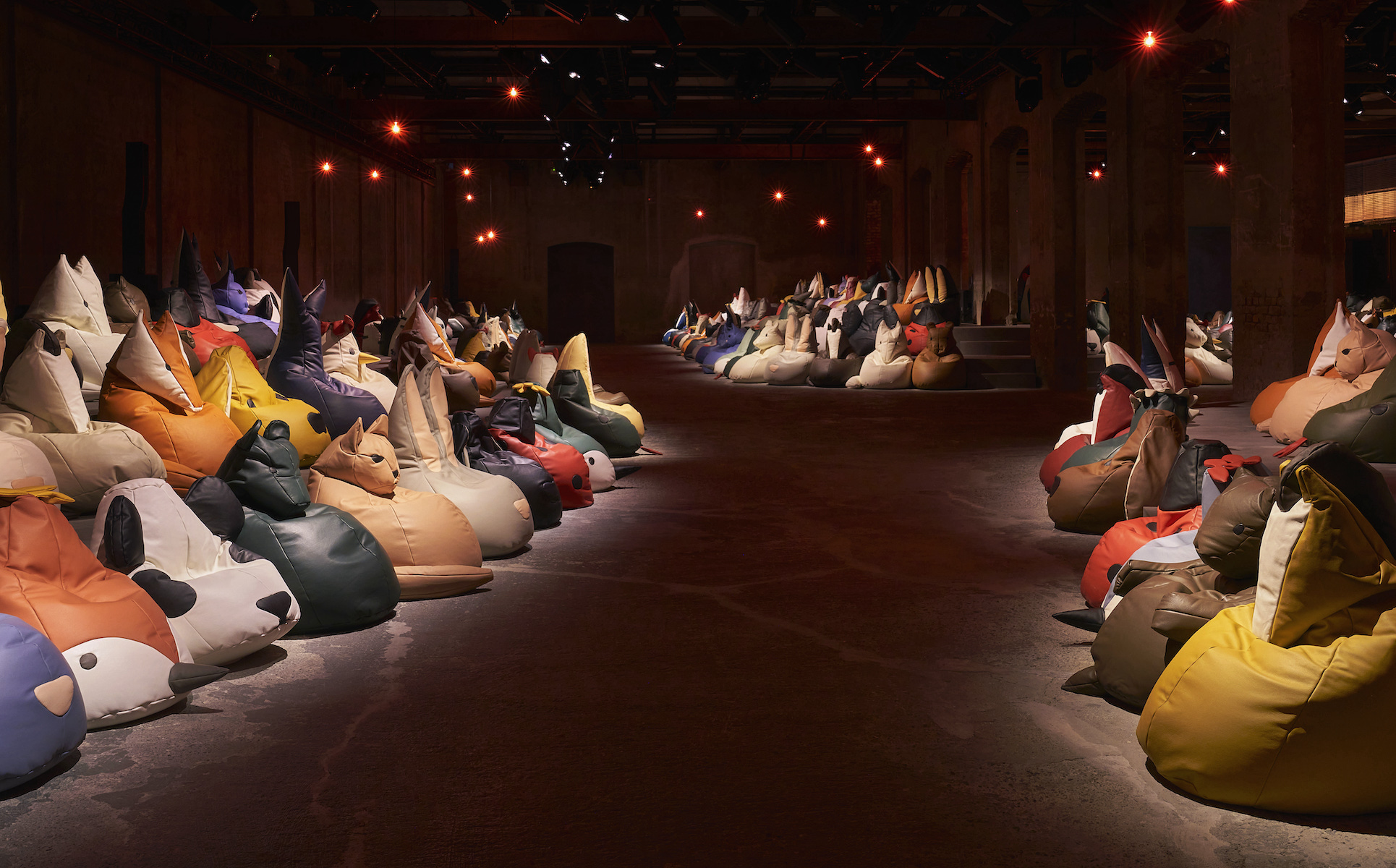
The S/S 2025 shows offered a typically transporting array of runway sets and show spaces, which spanned the romantic, the playful and the surreal, alongside the downright cinematic. Like Anthony Vaccarrello’s opulent, monolithic set for Saint Laurent – an enormous gilded circle that hovered over a circular blue runway – made all the dramatic by rain pouring through its open-to-the-elements ceiling.
Other brands drafted artists to create installations to backdrop their shows: there was Jonathan Lyndon Chase’s ‘messy, complicated’ domestic scene for Acne Studios, or Gary Hume’s reimagining of a 1990 work, ‘Bays’, for Daniel Lee’s latest Burberry show in London. Meanwhile, perhaps the most Instagram-friendly moment of the month came at Bottega Veneta, where Matthieu Blazy created a menagerie of leather beanbag animals inspired by a scene from E.T. (read on for the full story).
Here, selected by Wallpaper* fashion features editor Jack Moss, are the most breathtaking runway sets fashion month – a celebration of the architecture of fashion.
The best runway sets of S/S 2025
Artist Jonathan Lyndon Chase’s twisted living room for Acne Studios
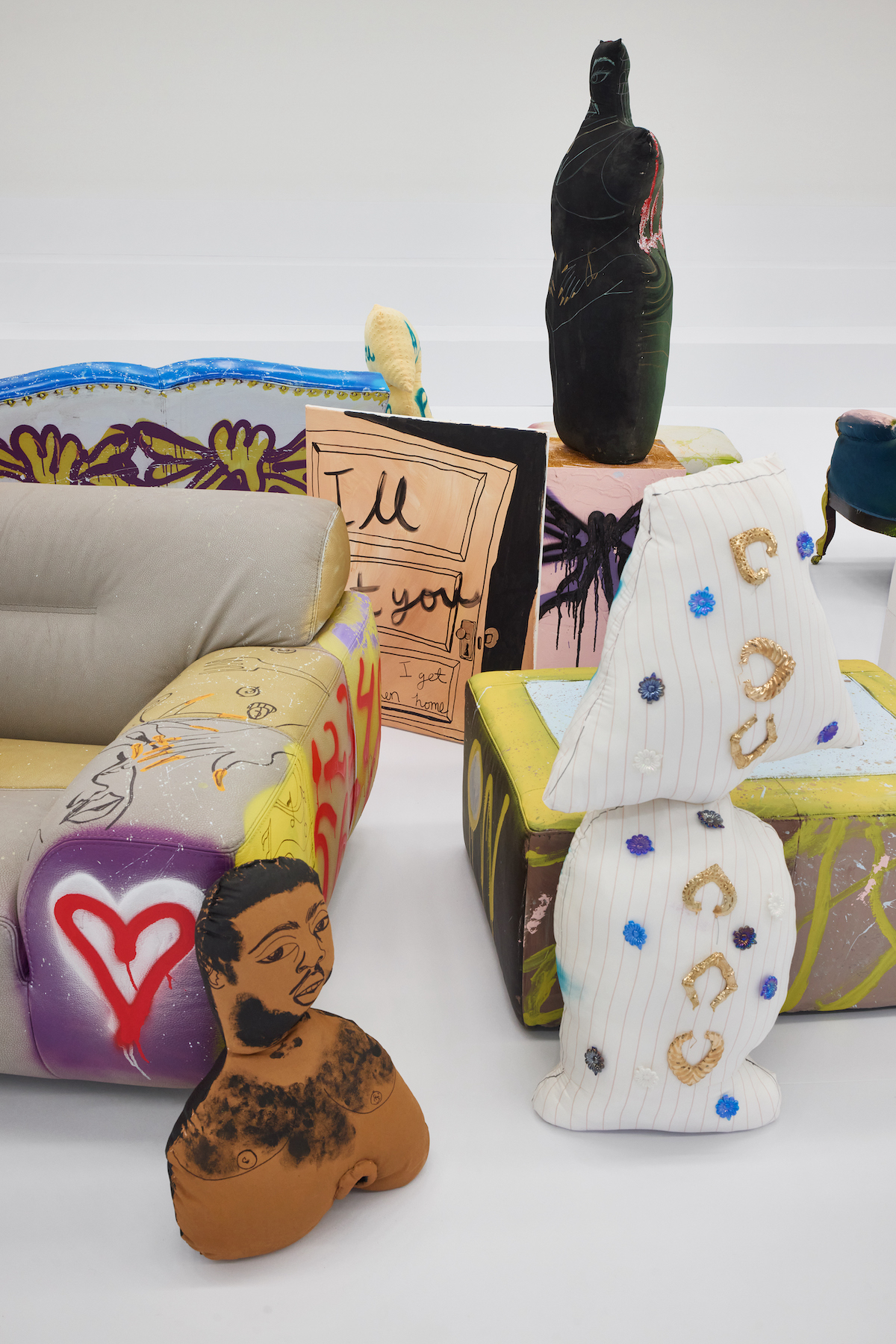
‘The idea for this collection started from a twisted domestic scenery. I asked myself whether classic domestic codes could actually be translated into fashion,’ explained Jonny Johansson of his surreal S/S 2025 Acne Studios collection, which reimagined home furnishings – from curtain ties to wax tablecloths – as clothing. Backdropping the show was a ‘complicated and messy’ domestic scene by Philadelphia-based artist Jonathan Lyndon Chase, comprising soft sculptures of lamps, radios and cats, alongside recycled furniture from Leboncoin scrawled with his playful motifs. Evoking a twisted living room, the artist told Wallpaper* that the installation was a musing on ‘emotions and the body, and how they affect the space around you’. Read more.
Bottega Veneta’s menagerie of bean-bag animals
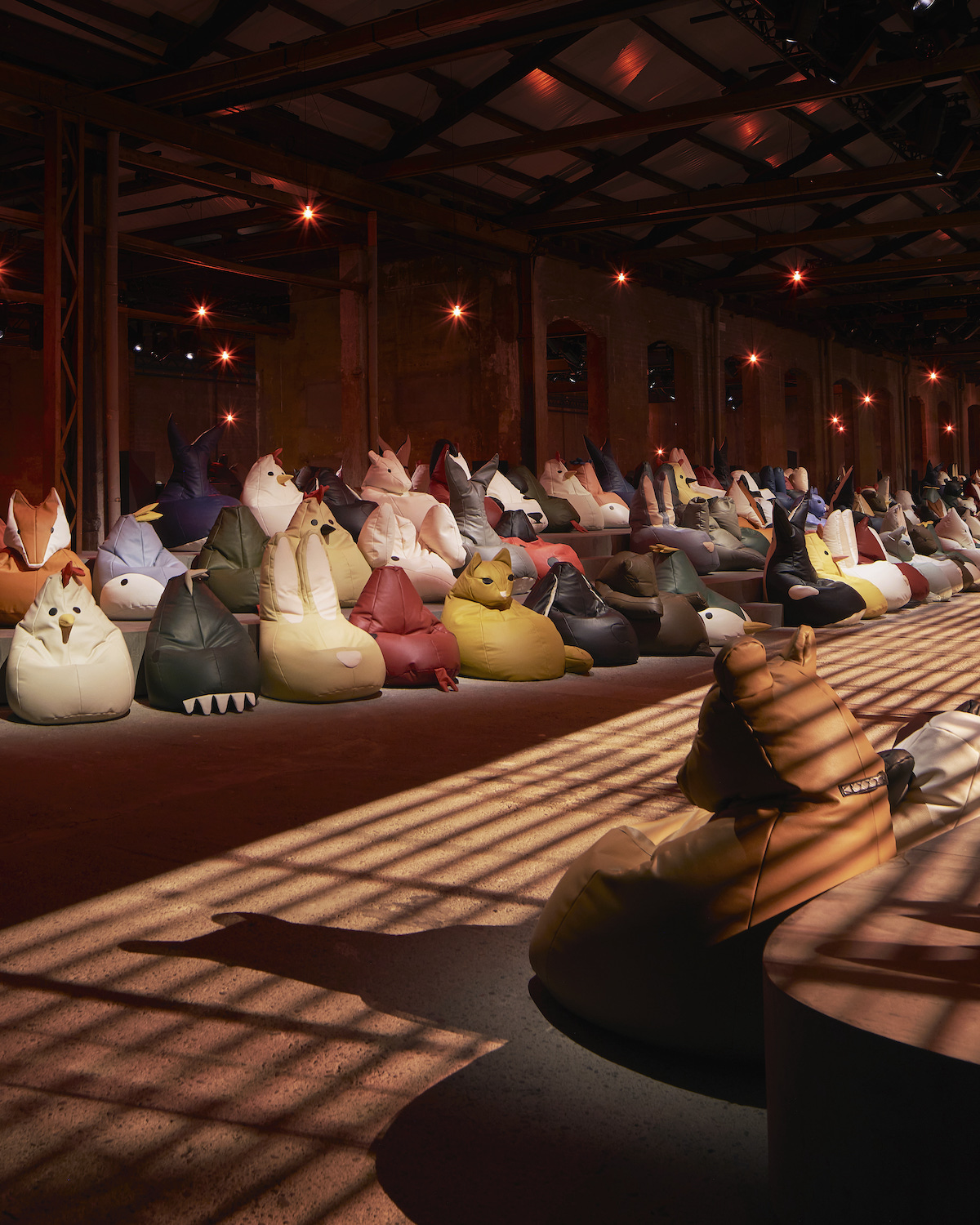
‘I was interested in the power of “wow”,’ said Matthieu Blazy of his latest collection for Bottega Veneta, which was inspired by a sense of childhood wonder, 'the joy of looking, discovering and dressing’. It was a mood reflected in the show space, a menagerie of leather beanbag chairs for guests to sit on – a reference, the designer said, to the scene in E.T. when the titular extraterrestrial hides amid a pile of soft toys in Elliott’s closet. Spanning killer whales, bunnies and foxes, the beanbag design was inspired by Zanotta’s ‘Sacco’ easy chair, with Blazy working with the Italian design company on the unique project. Read more.
Gary Hume’s reimagining of a 1990 work for Burberry
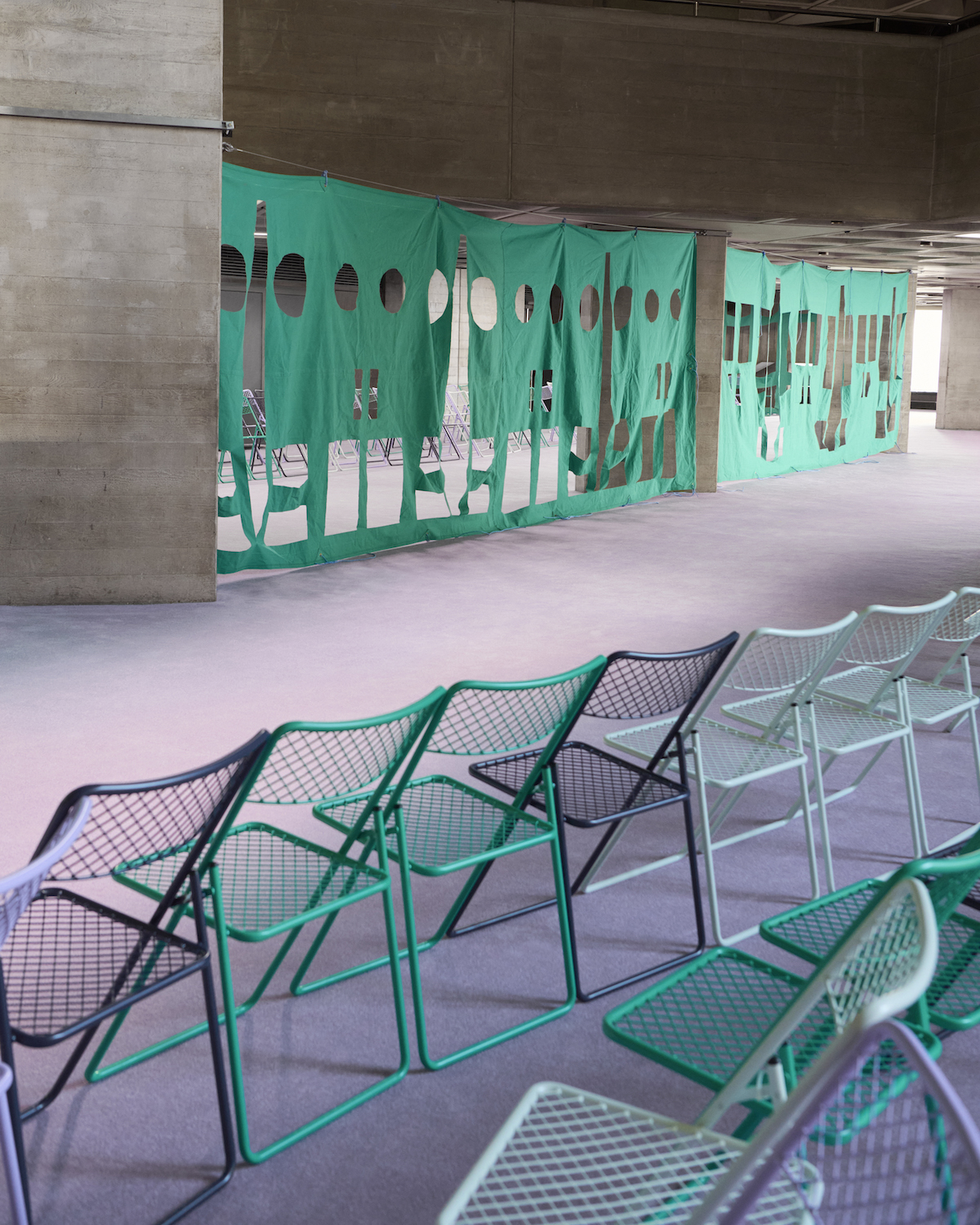
At London’s National Theatre, Daniel Lee looked towards artist Gary Hume – best known for being a part of the YBA movement, and currently showing at Sprüth Magers in London – to create the runway set for his latest Burberry collection, inspired by the artist’s 1990 work ‘Bays’. Originally staged as part of the notorious East Country Yard Show, the work comprises a series of lorry tarpaulins, hung like curtains and slashed to recall doorways and windows. Over three decades on, they were reimagined in medical green, lining the lobby of the brutalist theatre, which was partly chosen for the way it recalls the original concrete industrial space of the 1990 show. ‘I hadn’t touched the pieces in a long time, and so when Daniel asked me if I could participate in his show, I said yes,’ Hume told Wallpaper*. ‘There was a real bond of being two creative people.’ Read more.
Balenciaga’s dining-table runway, inspired by Demna’s childhood
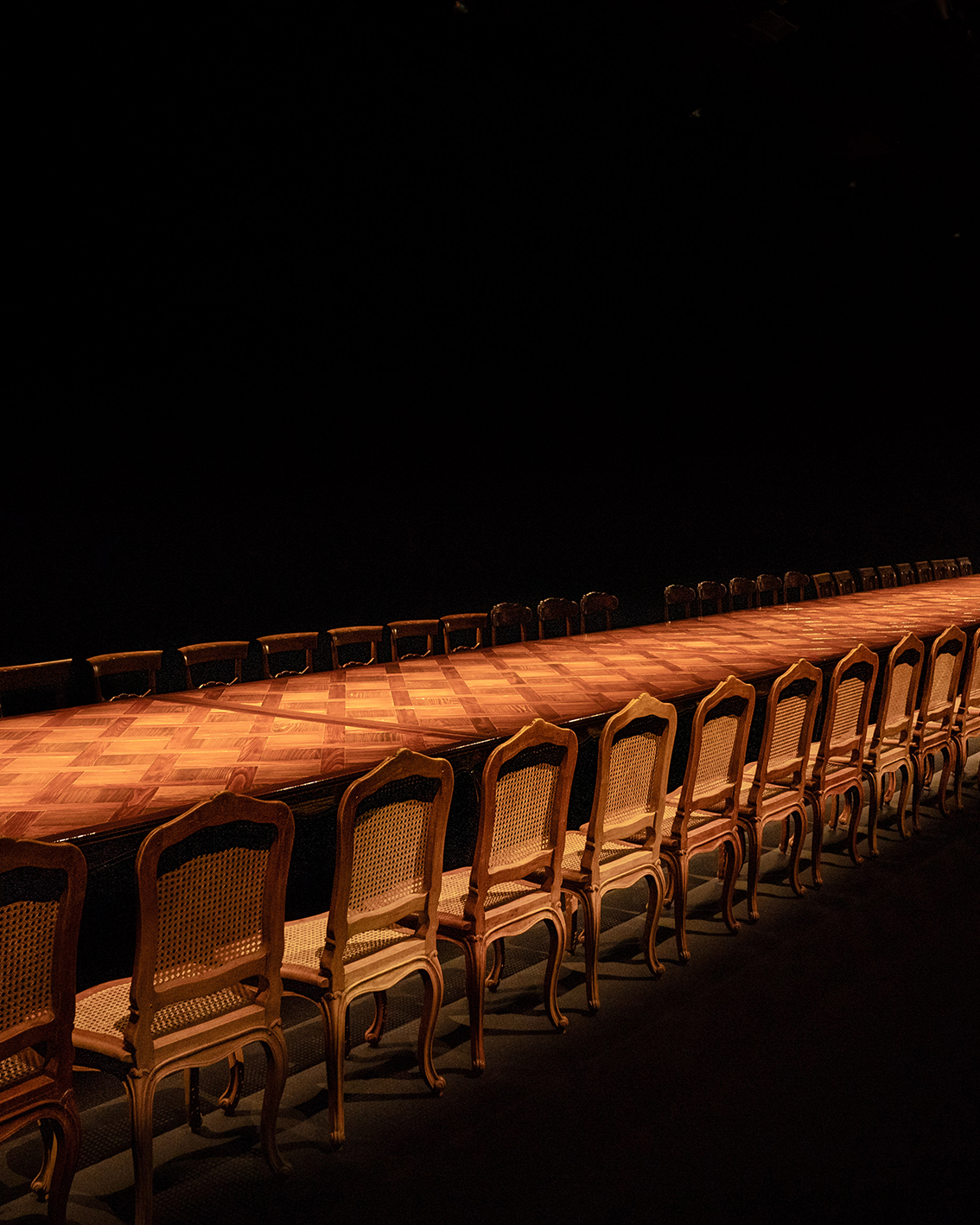
Demna said that this season began with reminiscences of holding fashion shows on his grandmother’s kitchen table in Georgia as a child. ‘My early memories of fashion start with me drawing looks on cardboard, cutting them away and making “fashion shows” on my grandmother’s kitchen table,’ he wrote in a letter to guests. ‘Thirty-five years later, this show reconnects me to the beginning of my vision. It’s a tribute to fashion which has a point of view.’ For the runway set, this scene was blown up to surreal proportions, with an enormous polished dining table – around which VIP guests sat – serving as the show’s runway.
Receive our daily digest of inspiration, escapism and design stories from around the world direct to your inbox.
Loewe’s ‘radically reduced’ runway set, featuring a Tracey Emin sculpture
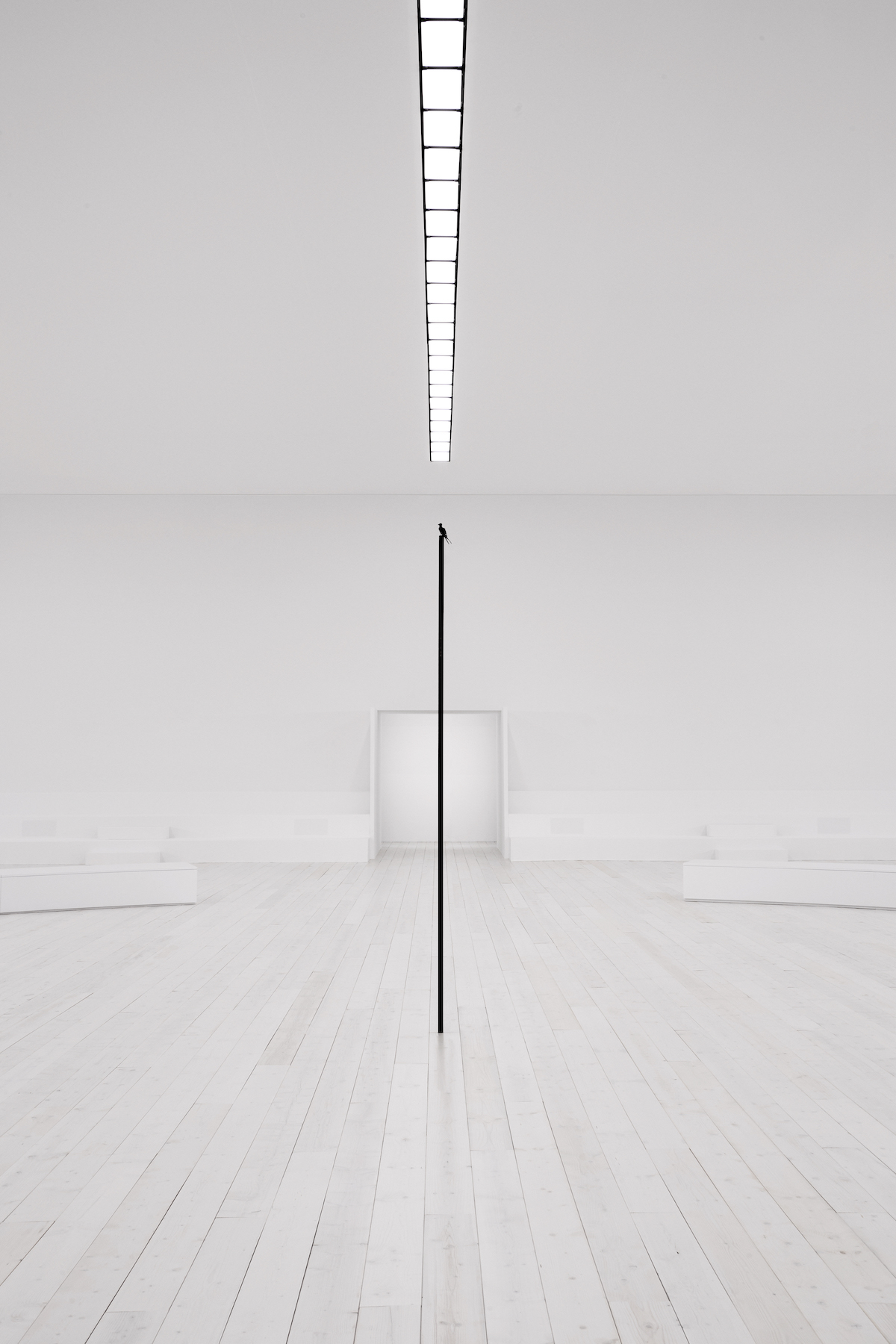
Jonathan Anderson described his latest Loewe show as an act of ‘radical reduction’, an attempt to replicate the ‘eye going into focus’ as your eyes adjust to a darkened room. The show space, constructed in a box in the grounds of Paris’ Château de Vincennes, was similarly spare: a vast white space with a circular runway that ran around a 2007 sculpture of a metal bird on a narrow, totem-like plinth by British artist Tracey Emin. Anderson said he liked the idea of the looks circulating around the sculpture ‘like a sundial’. ‘Caught in a moment of pause, [Emin] encourages us to imagine the bird’s imminent flight, and ultimately its freedom,’ said the designer via the collection notes.
Chanel’s blown-up birdcage, marking the house’s Grand Palais return
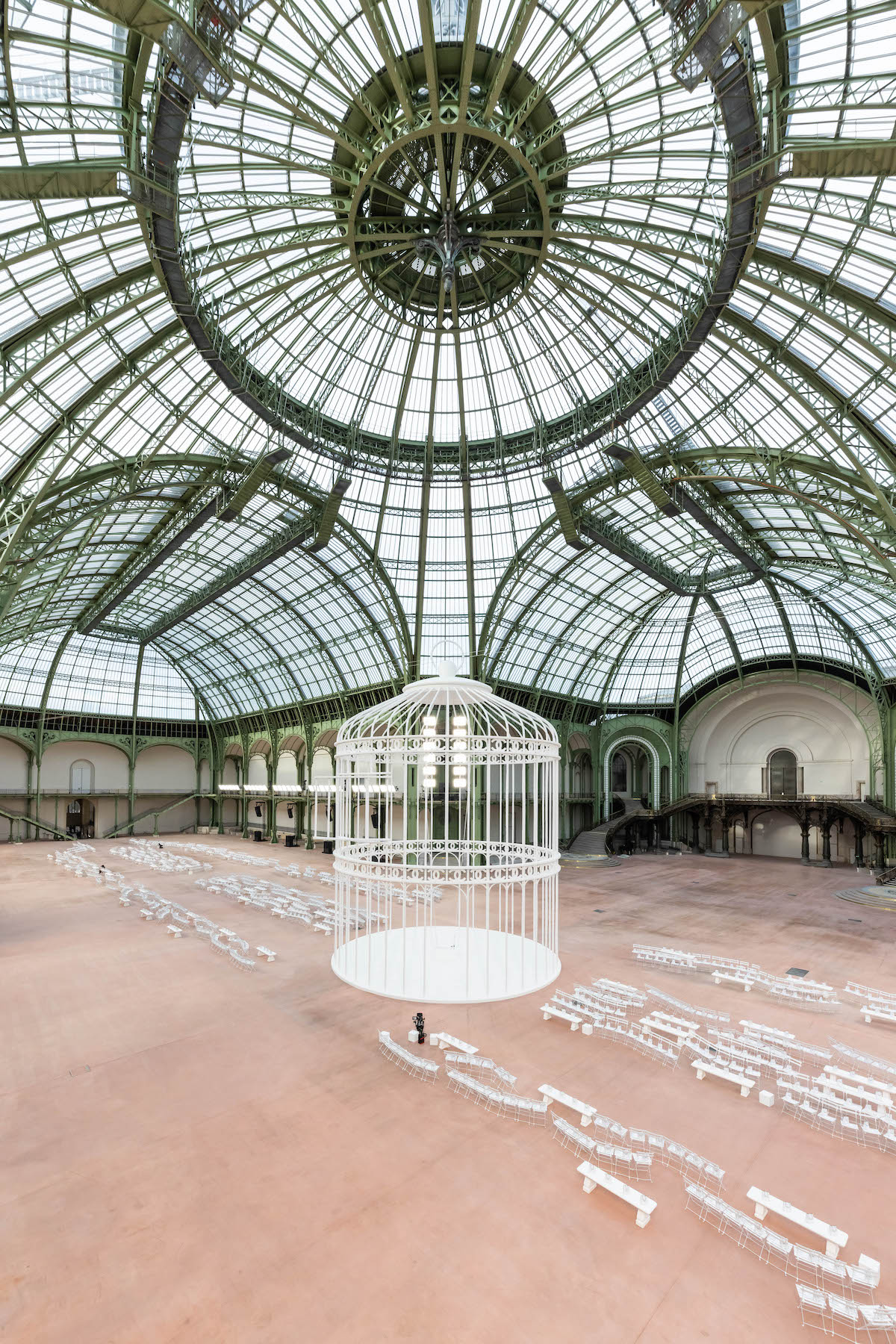
Chanel’s S/S 2025 show marked a triumphant return to the Grand Palais, the longtime site of the house’s runway presentations after the Beaux-Arts building was renovated to host the fencing competition during the Paris Olympics. Under the enormous glass roof, the house erected a giant birdcage, complete with the house’s double-C motif interwoven into its design. At the end of the show – which drew on bird motifs, from feather trims to feather prints – the actress-singer Riley Keough was lifted upwards on a swing inside the cage, singing a version of Prince’s ‘When Doves Cry’ as models took their finale circuit. It was a nod towards one of Chanel’s most memorable ads: the 1991 Coco L'Esprit de Chanel campaign starring house muse Vanessa Paradis as a feathered bird in a cage (though this time, the enormous fluffy white cat was missing).
Louis Vuitton’s raised runway, constructed from hundreds of the house’s signature trunks
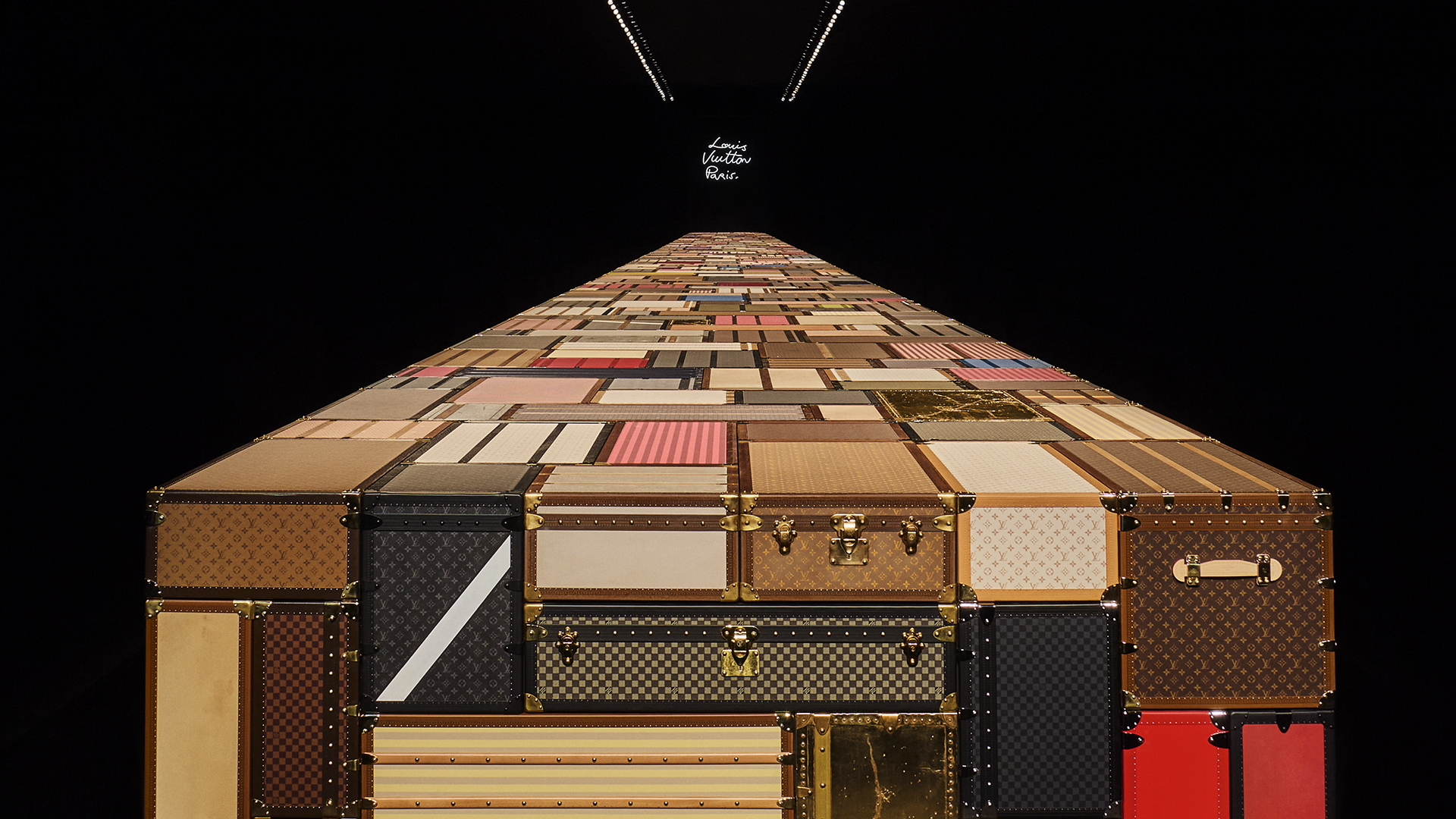
There was a hint of nostalgia to the runway set for Nicolas Ghesquière’s latest show for Louis Vuitton, which was staged on a raised runway and lit by a ‘Louis Vuitton Paris’ neon sign, recalling the amped-up fashion shows of the 1980s and 1990s. The runway itself was crafted from what appeared to be hundreds of Louis Vuitton’s signature trunks – spanning an array of eras and styles – all stacked up and hammered together, rising from the floor of the Louvre venue as the show began.
Archer-artist Sagg Napoli creates a fantastical show set for Dior

Maria Grazia Chiuri’s latest show began with the multidisciplinary Italian artist-archer Sofia Ginevra Giannì (aka Sagg Napoli) marching down the runway, bow in hand, before entering a Perspex corridor and firing shots on target. Carrying on the tradition of Chiuri collaborating with women artists, she had also designed the runway set. It saw the space in the gardens of Paris’ Musée Rodin transformed with an installation evocative of wrought-iron gates adorned with looping texts from the artist, who draws on the culture of southern Italy in her work. Meanwhile, an enormous Big Brother-style eye served as Sagg Napoli’s target – light work for the artist, who also has competed in national Italian archery competitions.
Alessandro Michele’s romantic, dust-sheet covered set for his Valentino debut
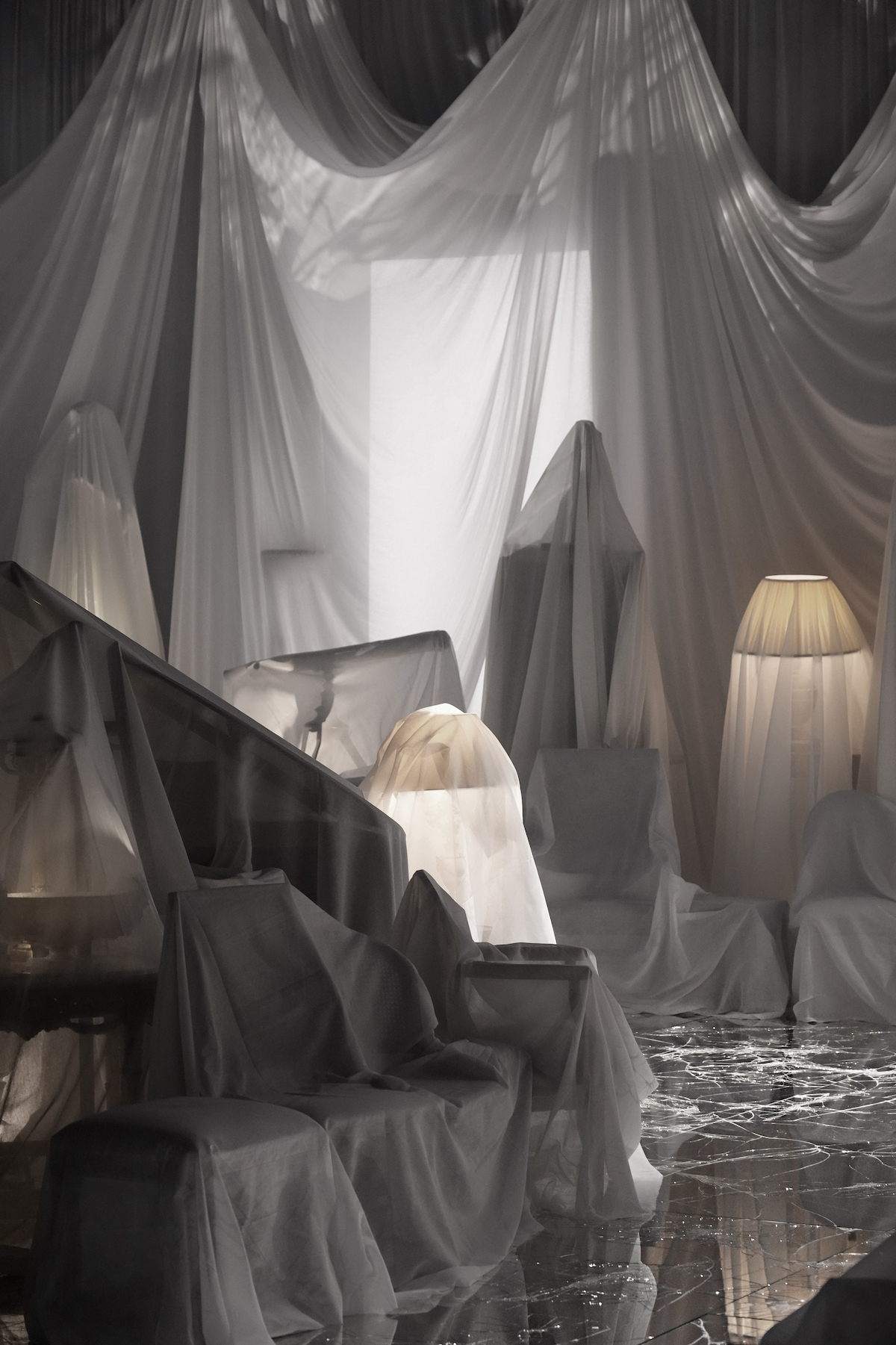
Fashion month’s most-anticipated moment took place in a judo stadium on Paris’ outer reaches, entirely transformed for the occasion by Italian design maverick Alessandro Michele, who was making his debut for Valentino after a two-year hiatus (he left his role as creative director of Gucci in 2022). Evoking what Michele deemed a 'Pavillon des Follies’ (which was also the title of the collection), the typically theatrical space saw the designer assemble a jumble of chairs, furniture and lampshades which were all covered in dust sheets, while the runway itself was made from shattered mirror, casting shards of light on the models’ faces. It provided an apt backdrop for Michele’s romantic exploration of beauty. ‘When I say beauty, I am clearly not referring to its universalistic, dogmatic and normative mythologisation,' he wrote in an introduction to the collection. ‘I rather allude to that unique capability to deeply feel and connect with something.’
Saint Laurent’s rain-soaked show space, which paid ode to Yves Saint Laurent’s Marrakech
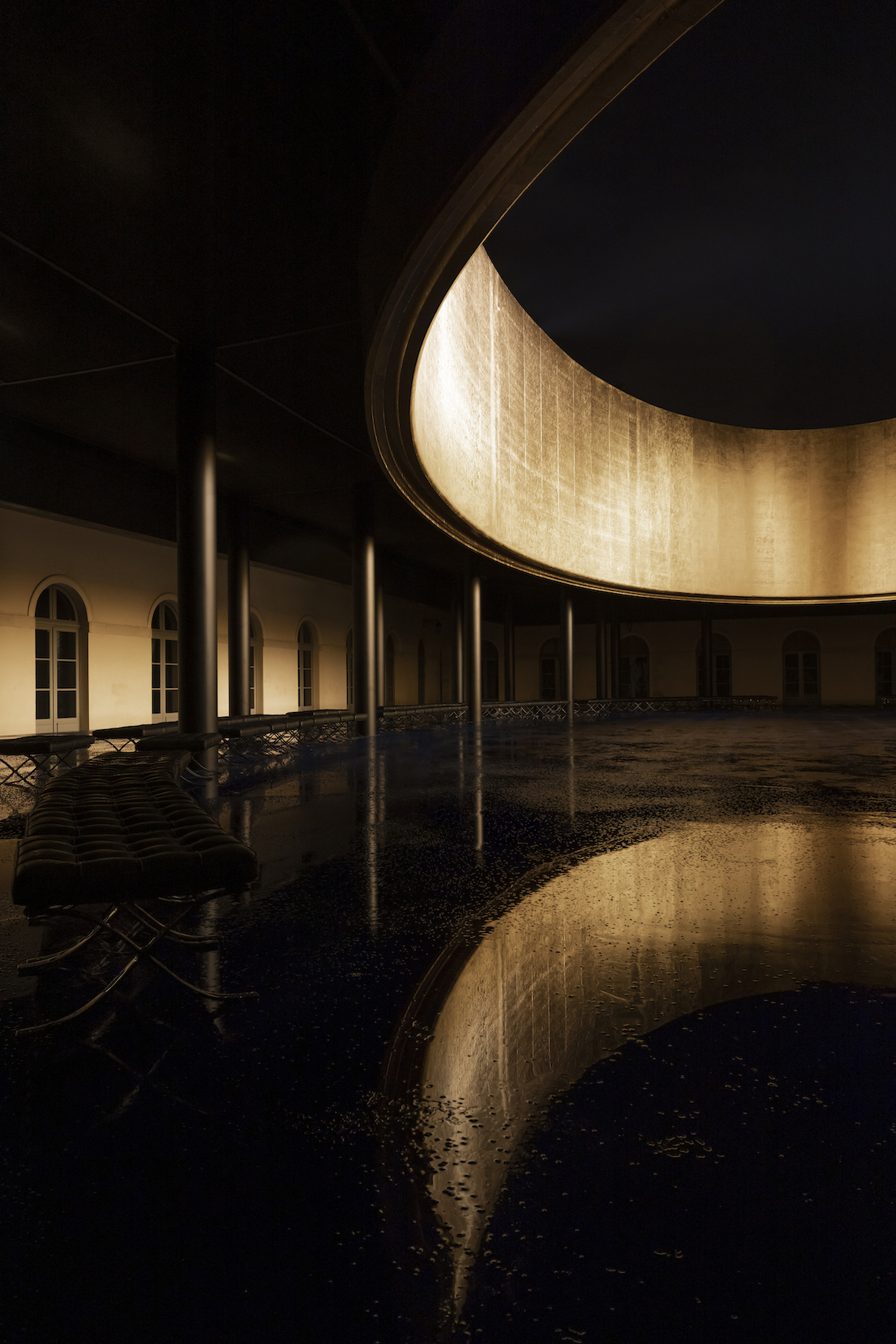
It was a return to Saint Laurent’s Rue de Bellechasse headquarters on Paris’ Left Bank for Anthony Vaccarello’s latest womenswear show for the house, a location that he had not shown at since his debut eight years ago. The monolithic set, created by Bureau Betak, comprised an enormous gilded circle – open to the elements – under which models walked on a slick blue runway, evocative of the blue used in the Saint Laurent gardens in Marrakech. It was made all the more strking by the fact that the rain was pouring, a final cinematic flourish to the already dramatic mise-en-scène.
Gucci’s setting sun at Milan’s Triennale Milano design museum

Milan’s temple to design, the Triennale Milano museum, provided the setting for Sabato De Sarno’s latest Gucci show, following a menswear presentation in the historic space earlier this year. This time, the designer created an enormous curving runway that looped around the museum’s ground floor, where various ‘rooms’ were designed to evoke a sunset, moving from yellow to orange to Ancora red, the deep oxblood hue that has become central to De Sarno’s tenure. The idea behind the exuberant collection was to capture a moment in time, just as the sun is rising or setting: ‘a moment to seize and live to the fullest’.
Fendi’s futuristic runway set, which came with a final surprise
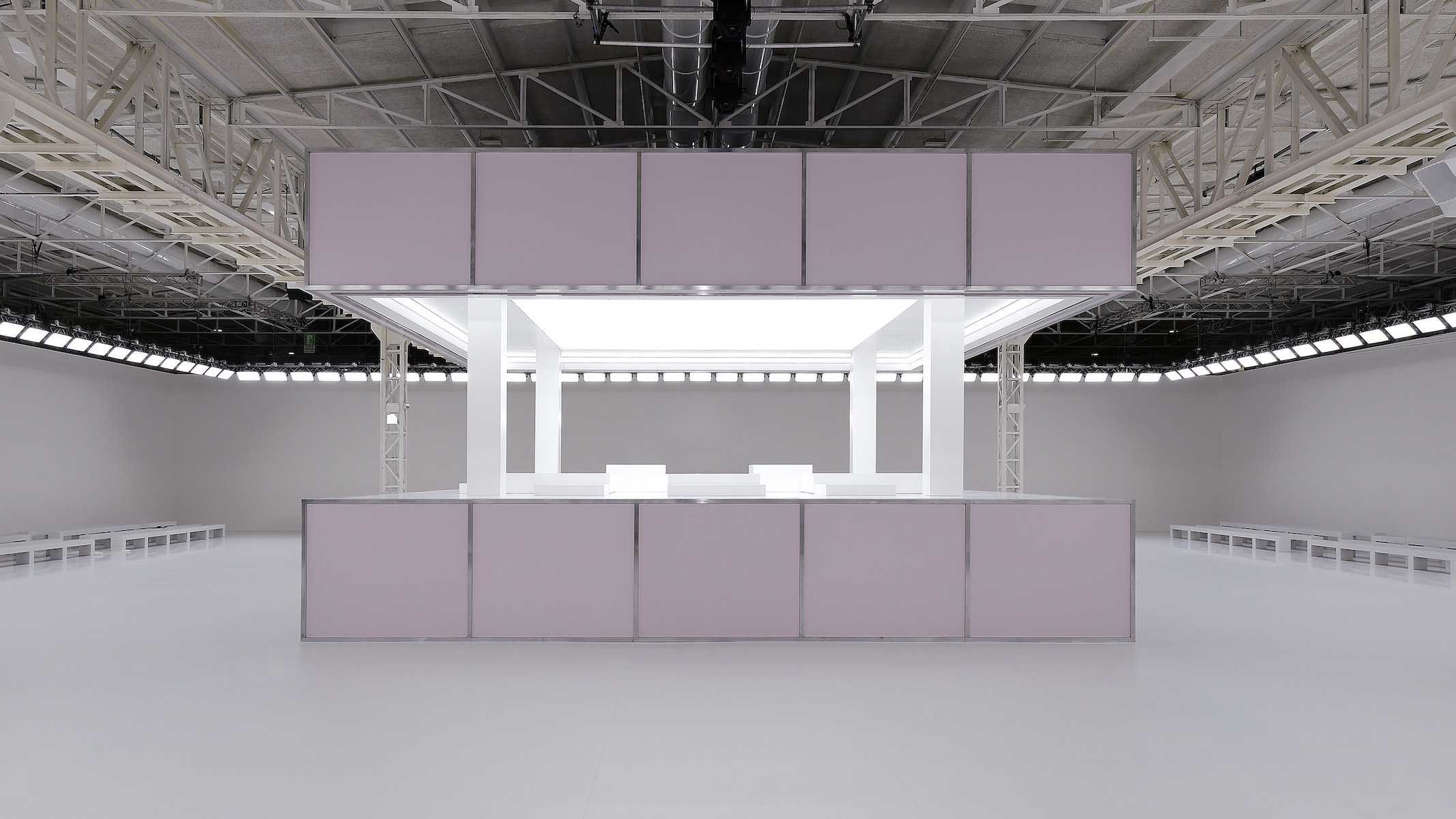
It was only fitting that what will be Fendi’s first collection of its centenary year (the brand turns 100 in 2025), was celebrated in theatrical style. In the centre of the vast, sound-stage-like space on the outskirts of Milan was an enormous, futuristic white box, into which models streamed after taking their loop around the square-shaped runway. It was to provide a moment of surprise: as the show ended, the box opened up, revealing a tableau of models inside. In their flapper-inspired dresses and nostalgic, crystal-adorned looks, it was a clash of past and present: ‘I wanted something romantic, something with a debt to the 1920s from the 2020s,’ said Kim Jones, artistic director of Fendi’s womenswear and couture.
For more on the latest fashion weeks, see our reports from the Paris, Milan, London and New York S/S 2025 shows.
Jack Moss is the Fashion & Beauty Features Director at Wallpaper*, having joined the team in 2022 as Fashion Features Editor. Previously the digital features editor at AnOther and digital editor at 10 Magazine, he has also contributed to numerous international publications and featured in ‘Dazed: 32 Years Confused: The Covers’, published by Rizzoli. He is particularly interested in the moments when fashion intersects with other creative disciplines – notably art and design – as well as championing a new generation of international talent and reporting from international fashion weeks. Across his career, he has interviewed the fashion industry’s leading figures, including Rick Owens, Pieter Mulier, Jonathan Anderson, Grace Wales Bonner, Christian Lacroix, Kate Moss and Manolo Blahnik.
-
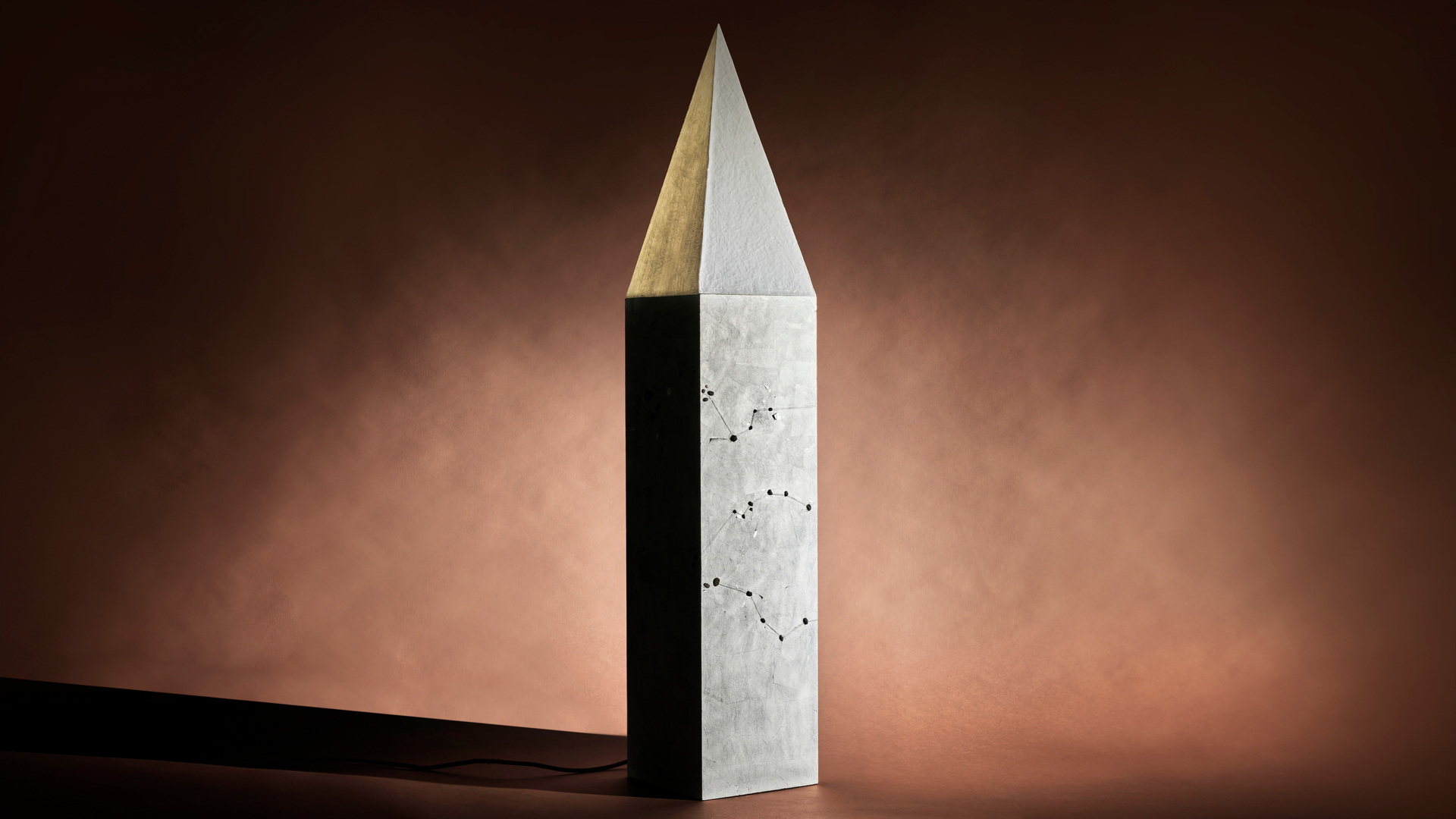 Design studio Palma is a tale of twos, where art and architecture meet
Design studio Palma is a tale of twos, where art and architecture meetWallpaper* Future Icons: in São Paulo, artist Cleo Döbberthin and architect Lorenzo Lo Schiavo blur the lines between making and meaning. Through Palma, they explore a dialogue shaped by material, memory and touch.
-
 This curved brick home by Flawk blends quiet sophistication and playful details
This curved brick home by Flawk blends quiet sophistication and playful detailsDistilling developer Flawk’s belief that architecture can be joyful, precise and human, Runda brings a curving, sculptural form to a quiet corner of north London
-
 Usher opens up about breakfast playlists, banana pudding and why a glass tumbler is always on his rider
Usher opens up about breakfast playlists, banana pudding and why a glass tumbler is always on his riderOn the heels of a collaboration with Baccarat, the Grammy-winning singer-songwriter breaks down his entertaining tips. 'Hosting is an expression of how you feel about your guests and also who you are.'
-
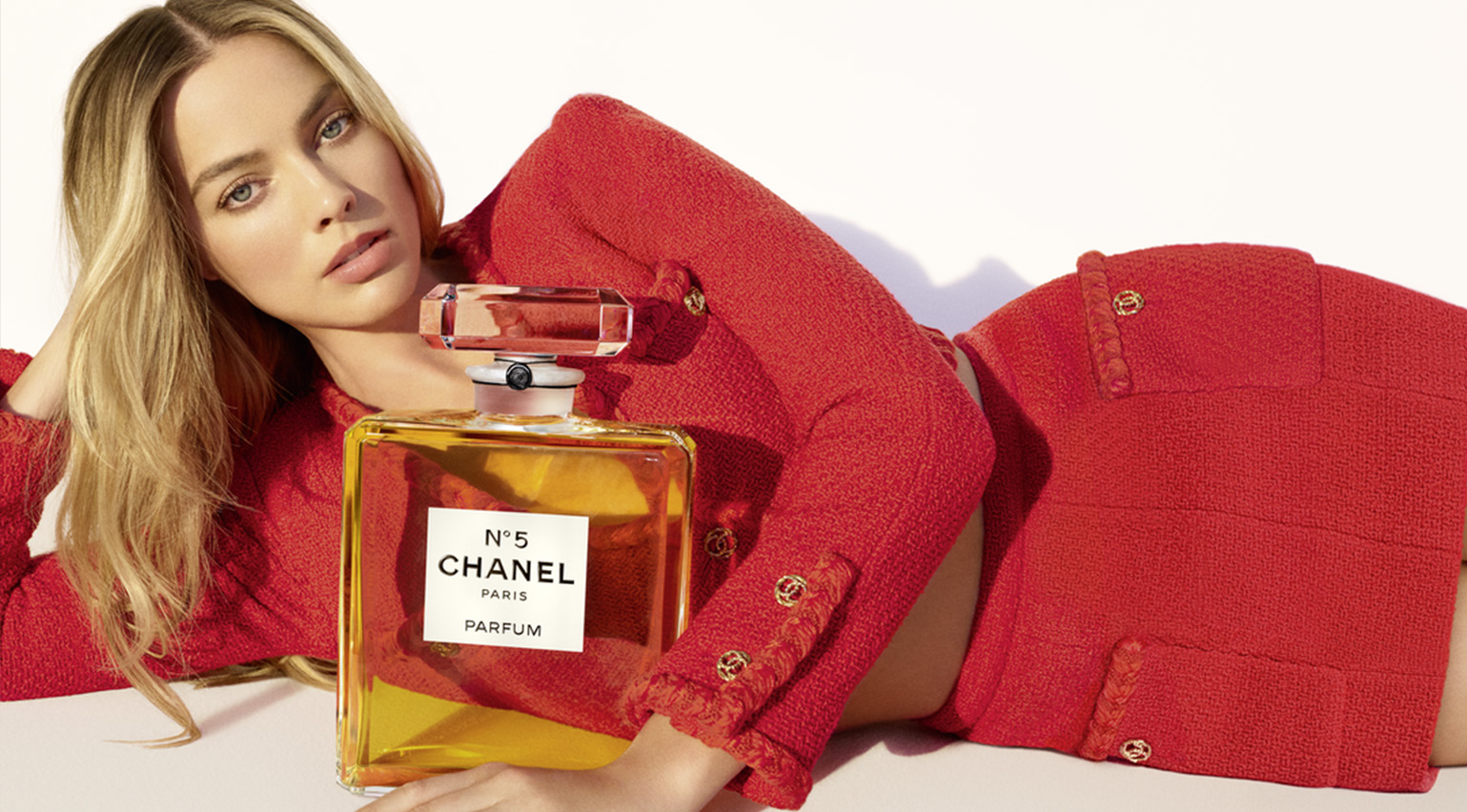 Margot Robbie, Marina Abramović and a 15-step Korean scalp treatment: the most-read Wallpaper* beauty stories of 2024
Margot Robbie, Marina Abramović and a 15-step Korean scalp treatment: the most-read Wallpaper* beauty stories of 2024The news of Margot Robbie becoming the face of Chanel No.5 and an illustrated guide to a 15-step Korean scalp treatment are just two of the most-read Wallpaper* beauty stories from the year gone by
-
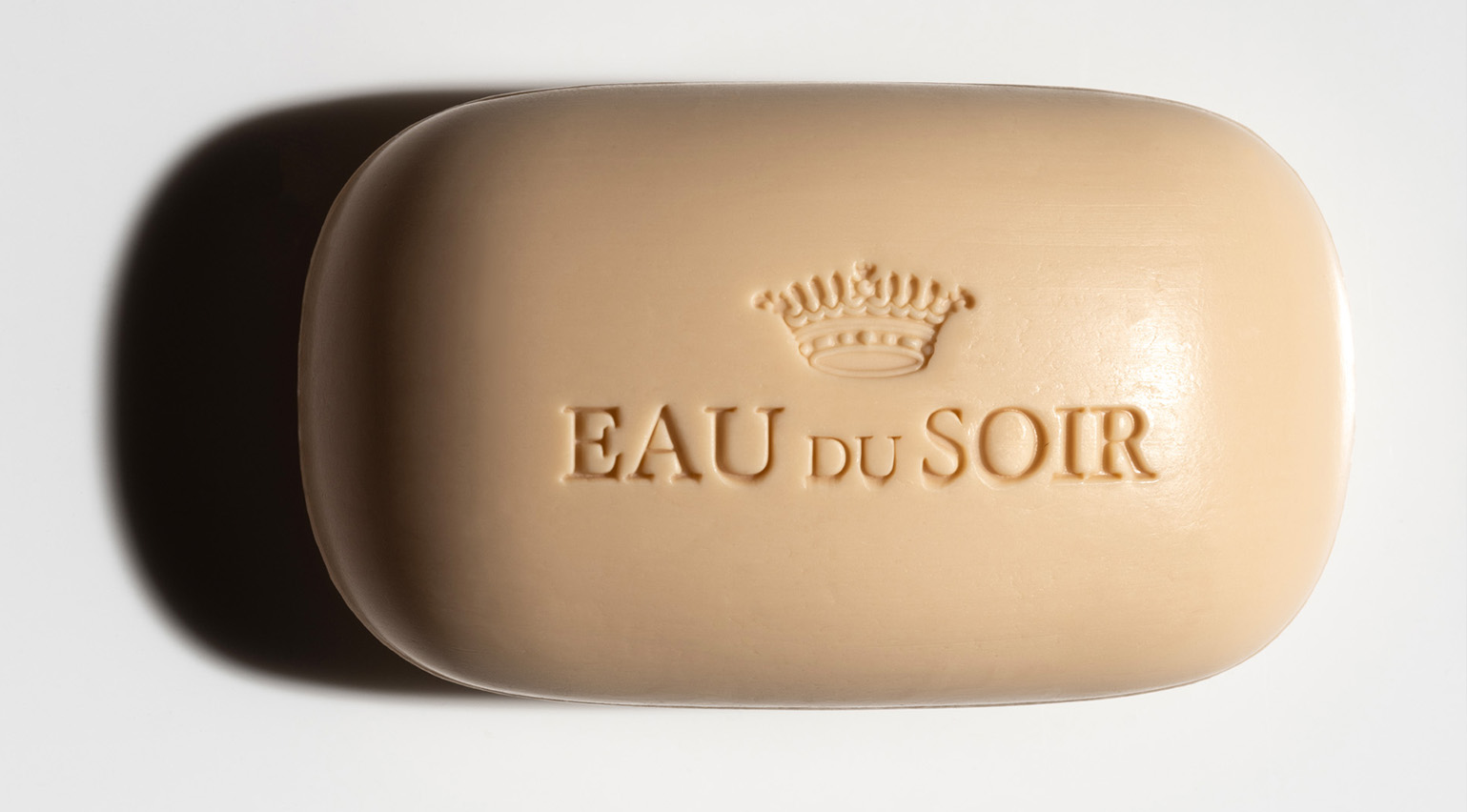 Unboxing beauty products from 2024, as seen on the pages of Wallpaper*
Unboxing beauty products from 2024, as seen on the pages of Wallpaper*Wallpaper's 2024 beauty picks included Chanel lipstick, Bottega Veneta perfume and solid soap from the likes of Aesop, Celine, Diptyque, Hermès and Sisley
-
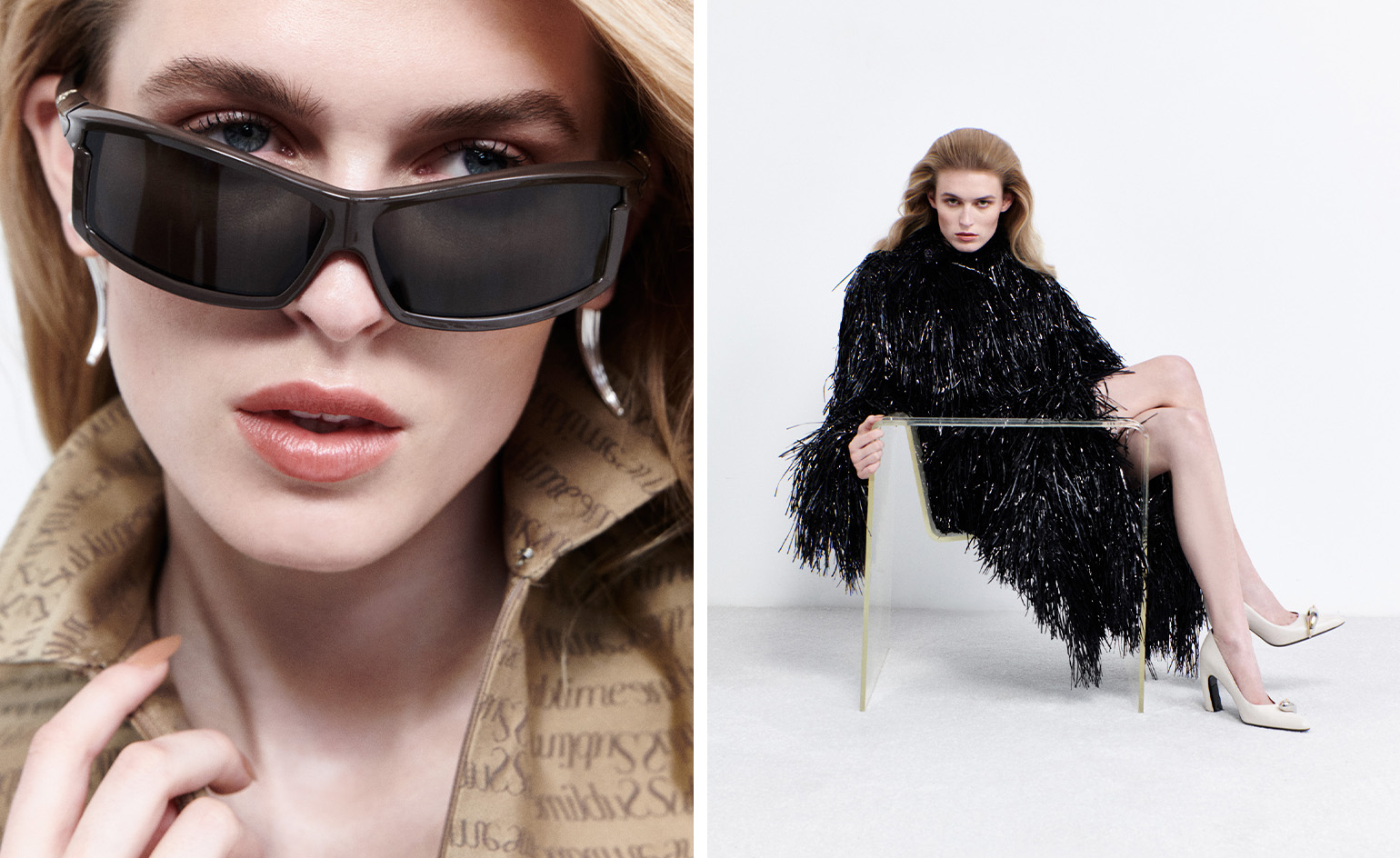 These illuminating fashion interviews tell the story of style in 2024
These illuminating fashion interviews tell the story of style in 2024Selected by fashion features editor Jack Moss from the pages of Wallpaper*, these interviews tell the stories behind the designers who have shaped 2024 – from Kim Jones to Tory Burch, Willy Chavarria to Martine Rose
-
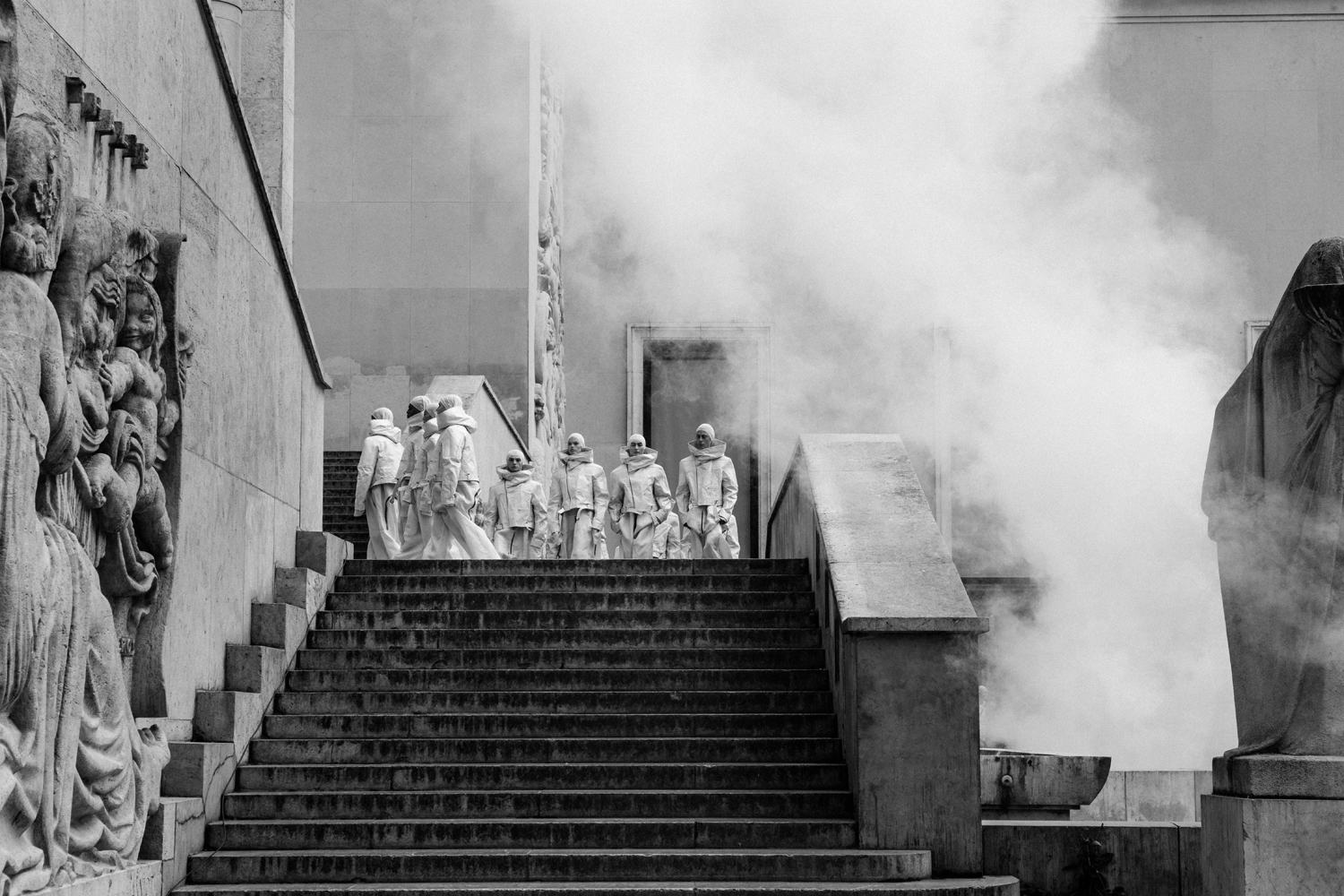 The Wallpaper* style team pick their fashion moments of 2024
The Wallpaper* style team pick their fashion moments of 2024The Wallpaper* style editors reflect on their best fashion moments of 2024, from Rick Owens’ 200-strong Hollywood epic to an Eyes Wide Shut-inspired JW Anderson show, and a slicked-back beauty look at Saint Laurent
-
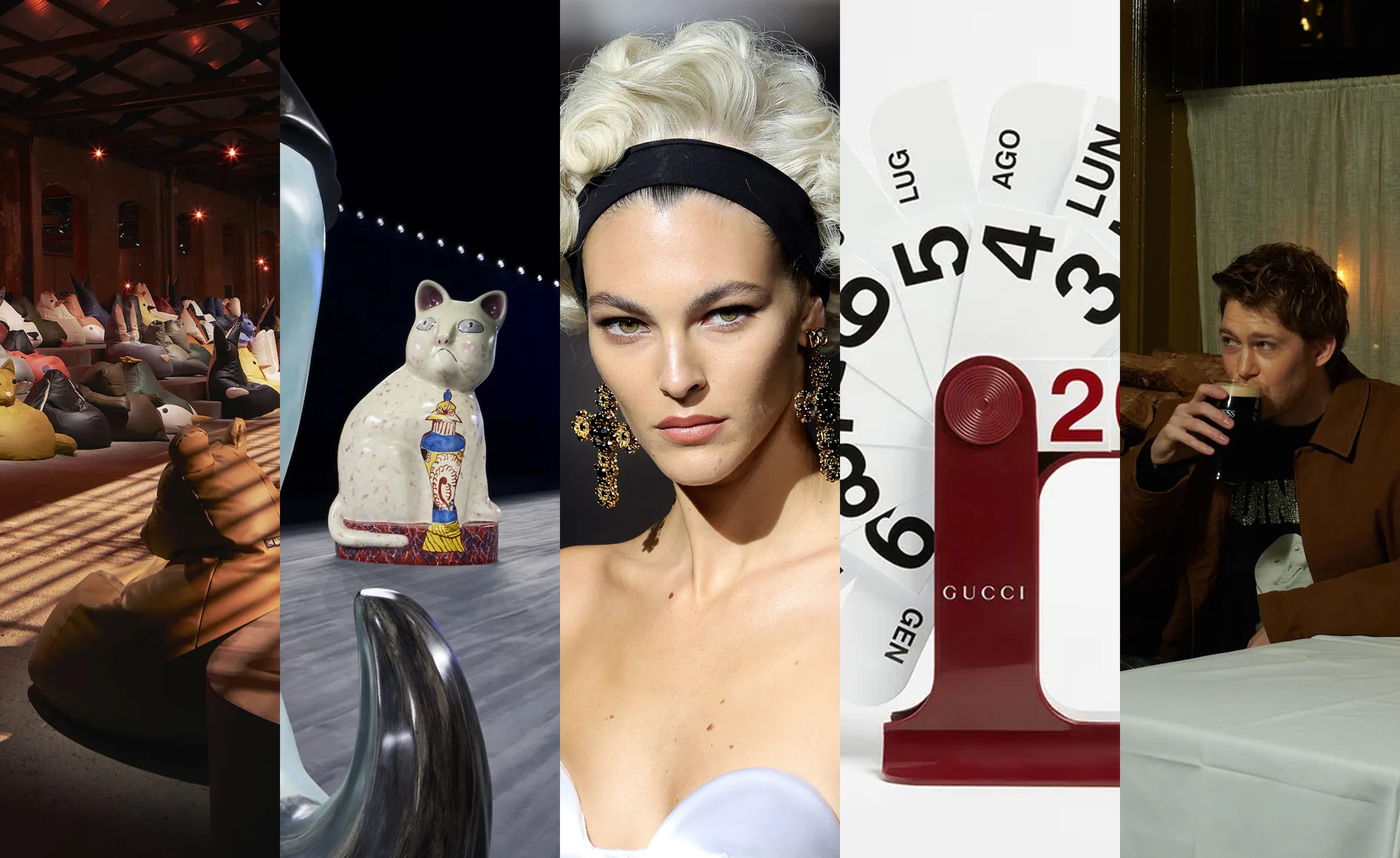 Giant cats, Madonna wigs, pints of Guinness: seven objects that tell the story of fashion in 2024
Giant cats, Madonna wigs, pints of Guinness: seven objects that tell the story of fashion in 2024These objects tell an unconventional story of style in 2024, a year when the ephemera that populated designers’ universes was as intriguing as the collections themselves
-
 How 2024 brought beauty and fashion closer than ever before
How 2024 brought beauty and fashion closer than ever before2024 was a year when beauty and fashion got closer than ever before, with runway moments, collaborations and key launches setting the scene for 2025 and beyond
-
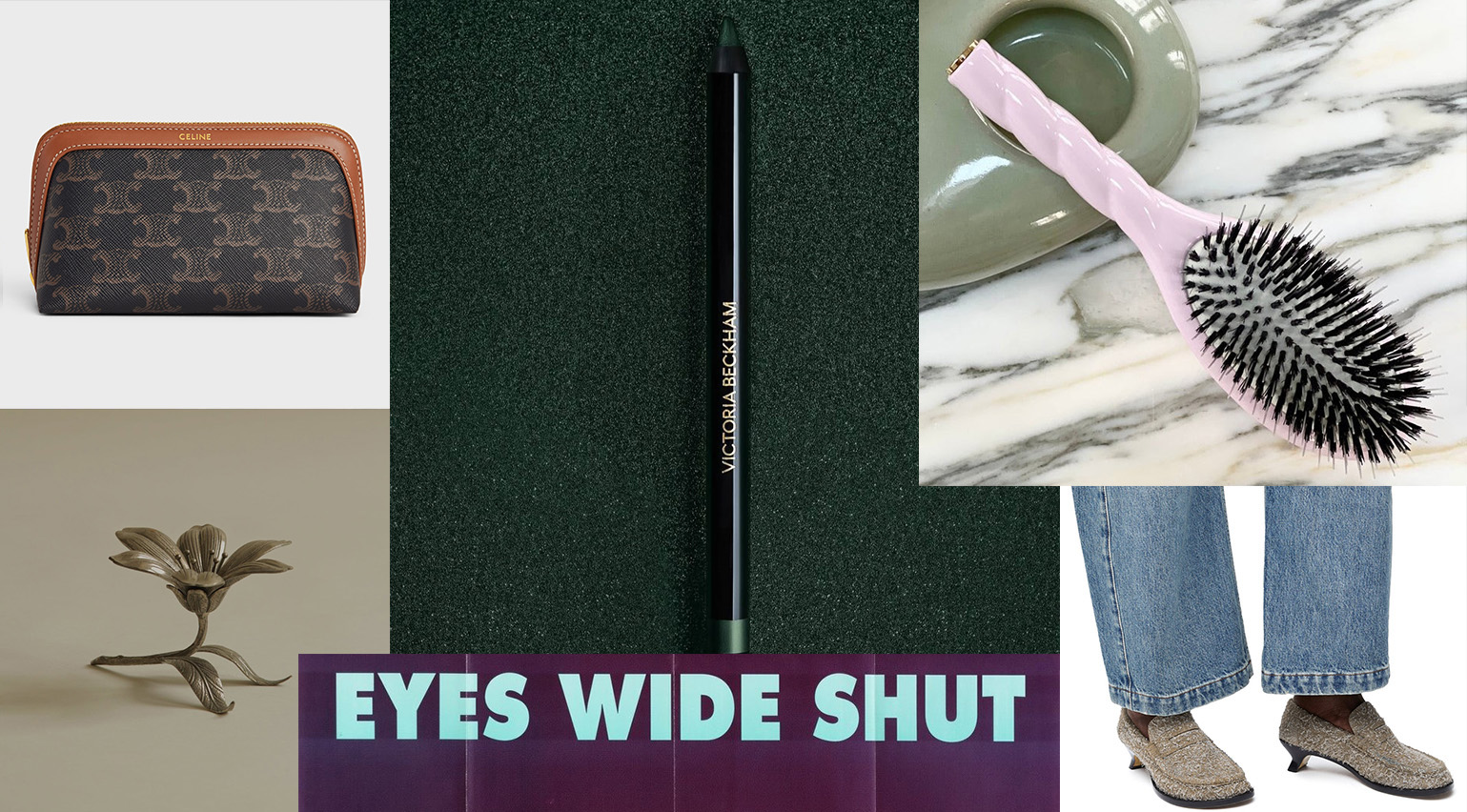 Wallpaper* beauty editor Hannah Tindle’s eclectic gift guide
Wallpaper* beauty editor Hannah Tindle’s eclectic gift guideWallpaper* beauty editor Hannah Tindle ideas for festive gifting include a scalp-stimulating hairbrush, a mid-century ‘party’ ashtray and an archival poster for Stanley Kubrick’s Eyes Wide Shut
-
 20 years of Dover Street Market’s transporting in-store installations, from giant elephants to soft toys
20 years of Dover Street Market’s transporting in-store installations, from giant elephants to soft toysAs Dover Street Market, Rei Kawakubo and Adrian Joffe’s radical London concept store, celebrates its 20th anniversary, we look back at ten of its most colourful installations, crafted alongside Simone Rocha, Jonathan Anderson, Martin Parr and more